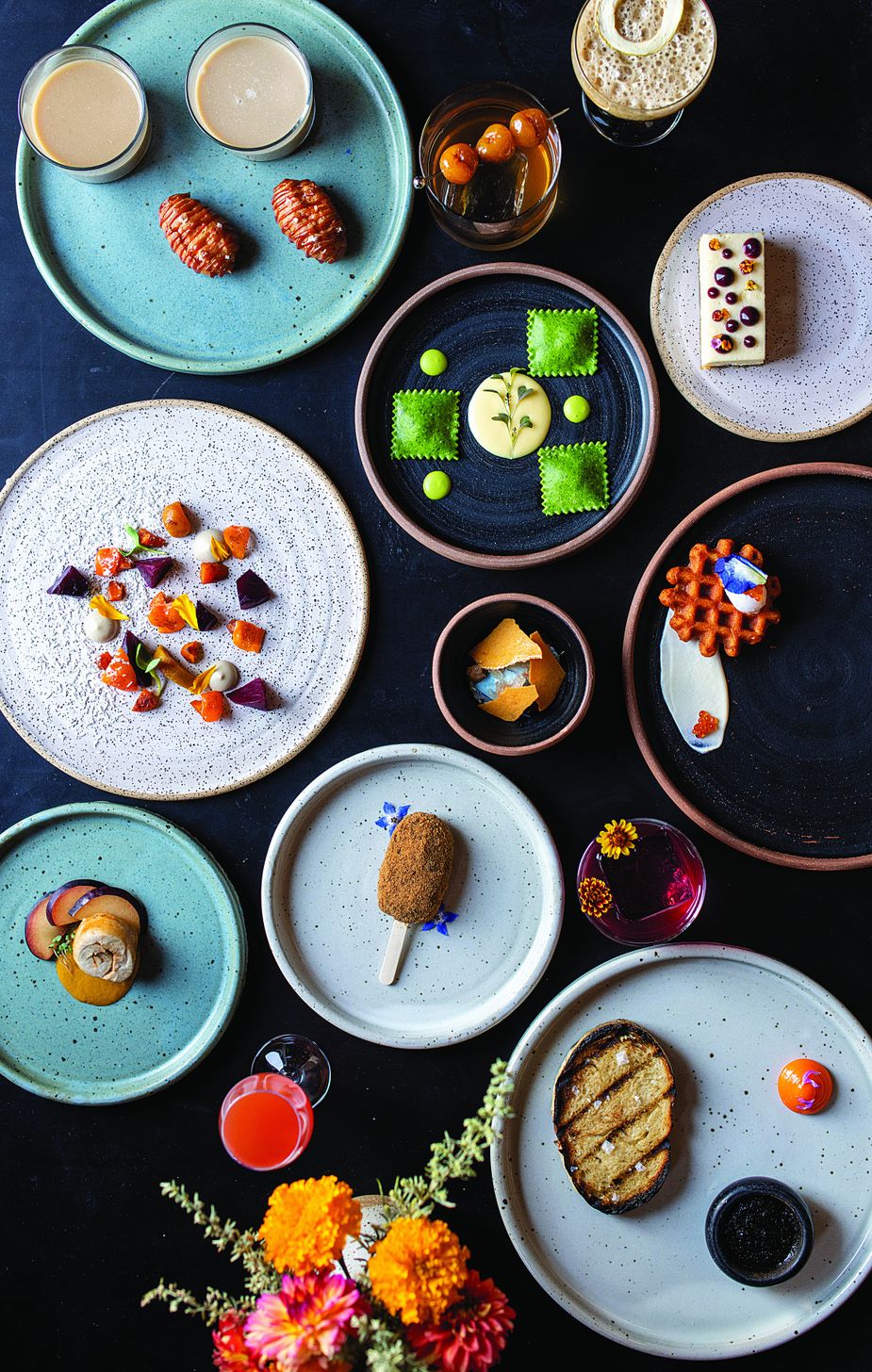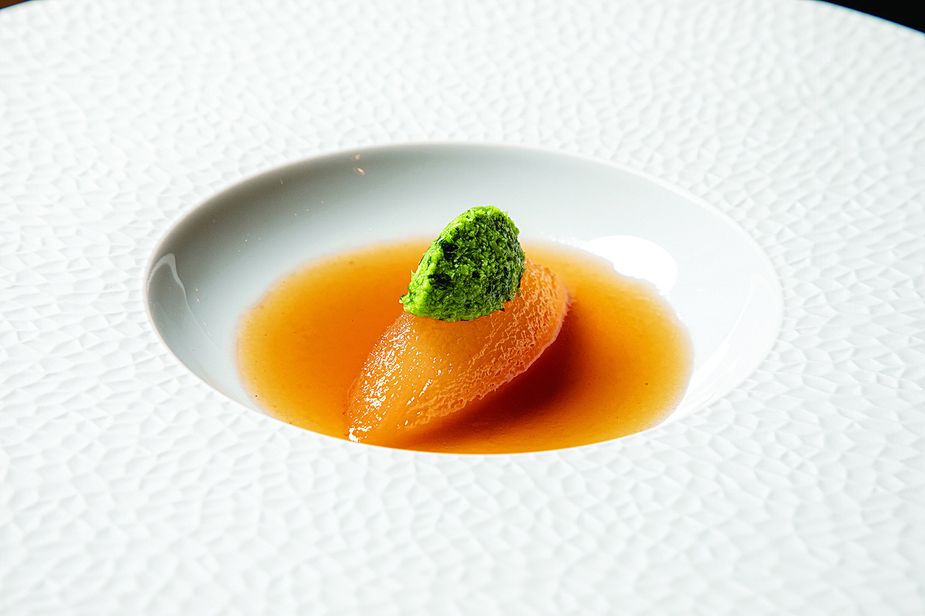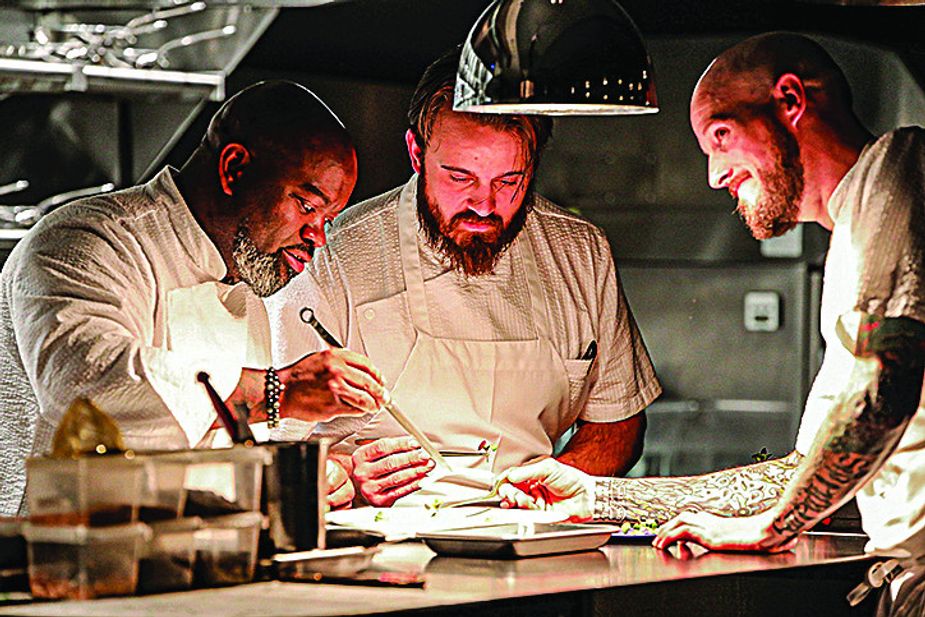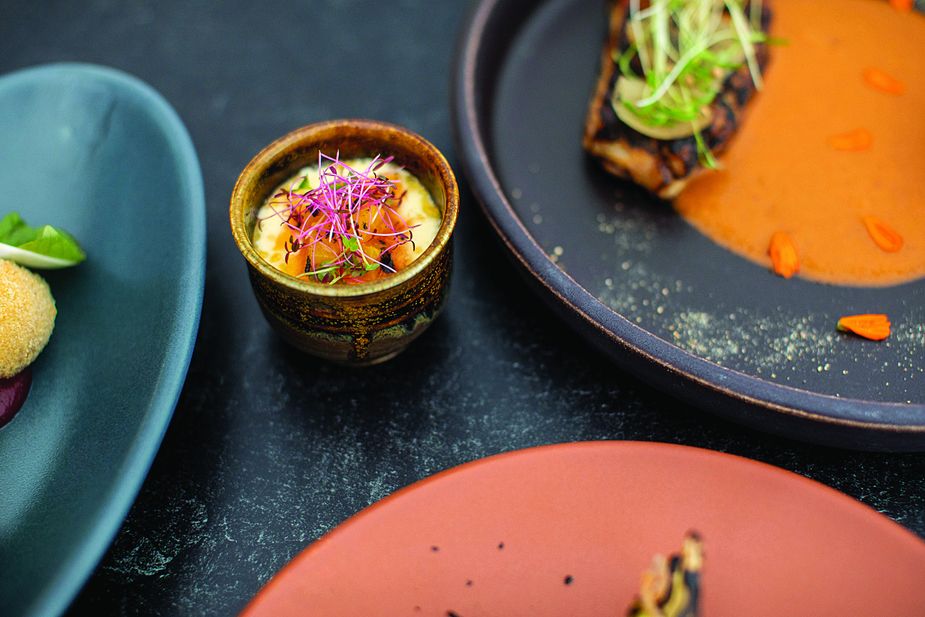Leap of Taste
Published February 2022
By Greg Elwell | 17 min read
There is no indulgence like faith.
“I feel like Thai food.” “Mmm, pizza sounds good.” “Let’s try that new diner.”
When people eat out, they generally like to have an idea of what they’re going to consume before choosing a restaurant, even if they’re not sure what they’ll order when they get there. But over the last few years, a new type of dining experience has appeared in Oklahoma in the form of tasting menu restaurants. The menu is not posted, and customers wouldn’t be allowed to order off it even if it were. At these restaurants, diners buy a ticket for a mouth-first leap of faith.
A tasting menu restaurant serves a series of small dishes, generally in several courses, without the diner ever placing a personal order. Everyone, more or less, is served the same dishes in the same sequence. Guests do not choose; their only job is to sit back and enjoy what comes to them. Some eateries have a set number of courses for all meals, while others let diners pick and choose among tiers. Some have set themes for some meals, and others are some version of “you get what we give you.”
The concept has gone mainstream in recent years. In 2018, Bon Appétit magazine named Oklahoma City’s Nonesuch its Best New Restaurant in America, immediately expanding the waitlist for reservations from a week to months at a time. In the intervening years, two head chefs have moved on, and now Justin Brown, who migrated with his wife to Oklahoma from Napa, California, has taken the reins. Napa, home of many American wineries, is a place built on the hospitality industry, so the culture shift to Oklahoma was a big one, says Brown.

Named America’s Best New Restaurant by Bon Appétit in 2018, Nonesuch in Oklahoma City is a multi-course culinary adventure for those who like to push the bounds of gastronomy. Photo by Rachel Maucieri
“Everything there is geared toward the food and wine industry, so working in those restaurants was like full immersion,” he says. “Oklahoma isn’t as over the top, and the food is a lot more approachable here.”
Brown and his team are incorporating some of what he learned on the West Coast with the structure his predecessors put in place at Nonesuch.
“When we were still in California and talking about moving here, my wife found Nonesuch and showed it to me,” he says. “And all I could think was, ‘If we’re going to move to Oklahoma, that’s the only place I’m going to work.’”
Open just four days a week and only for dinner, Nonesuch is a restaurant with just one table—a sleek wraparound U-shaped bar surrounding the serving area. The farther away the seats are from the door, the closer diners are to the open kitchen, where they can watch chefs melt a cheesy mornay sauce over a tender piece of bison and artfully place pieces of pea flowers atop a floral ice cream served with melon granita.
Prices begin at $125 per person for roughly ten courses with upgrades available for wine and non-alcoholic drink pairings. Once a reservation is confirmed, in the days leading up to the meal, a staff member calls to check on allergies or other dietary restrictions. For a culinary experience that once started with a tray of artful nibbles—including a savory artisan Pop-Tart called “The Snack Attack”—it seems pretty formal, but after that, the fun begins. And while the menu isn’t revealed to diners until after the meal is through, guests can be assured the restaurant will adhere to its theme: hyper-local, hyper-seasonal ingredients served in innovative and delicious ways.
“I’m from Florida and California, where chefs can kind of have anything they want at any time. But with this kind of concept in Oklahoma, you really have to be creative,” Brown says. “The chefs before me set up amazing programs for how to use and preserve ingredients from season to season.”
For example, the shelves above the door to the kitchen at Nonesuch are adorned with bottles and jars, but they’re more than decorations. The secret to stretching out Oklahoma’s bounty all year is the ability to preserve wild persimmons and other ephemeral ingredients as powders, vinegars, and infusions.

Photo by Lori Duckworth

Confit tomato (above) and the turnip are among the dishes at Grey Sweater’s elegant Deep Deuce location. Photo by Lori Duckworth
A few blocks away is Grey Sweater, where owner and chef Andrew Black has created something of a complement to Nonesuch. The same rules apply—diners buy a ticket of either five, seven, or ten courses with wine or cocktail pairings available and no idea what food will be served—but instead of hyper-local and hyper-seasonal, the restaurant is all about getting the best available from anywhere in the world.
“We talk about having no allegiances,” says Black.
The lilt in his voice gives away his international origins—and so does his cooking style. Originally from Jamaica, he has cooked for audiences around the globe. His team promises no boundaries or barriers for their guests’ dining experience. The only problem, he says, are the boundaries diners put on themselves: With prices starting at $97 per person for the five-course menu and all the way up to $187 for the ten-course meal, it’s understandable that customers might feel a little stiff when they walk through the doors.
“That’s when we give them a turnip,” he says.
The turnip is a recurring dish at Grey Sweater. Carved into an ovalesque football and braised until tender, it’s a single bite of vegetable that has been transformed into an earthy spheroid of sweetness served in a bowl with a small ladling of broth. There’s neither silverware nor much of an explanation. The server just politely says, “The chef recommends eating this with your fingers,” and then walks away. It’s an ice breaker for Black; a shot across the bow of fine dining and expectations.
“When they take that first bite, you see their shoulders relax and a smile on their faces,” he says. “Their minds open up to the possibilities, and they let go. They’re ready to come on the journey, and we have to live up to it every day.”

Chef Andrew Black, left, works with his crew at Grey Sweater
Black’s aim is simple: No matter how much his guests spend on dinner, he hopes they feel it was a bargain.
“I want to make this food worth more than what you have paid for it, but I also need to know that you’re going to come in here with an open mind and not just expect the same stuff you could get at a steakhouse,” he says.
Few steakhouses have the guts to serve cauliflower ice cream cones or an oyster served on the half shell with frozen dehydrated strawberries. It’s food some might call fussy, with tiny herbs and accents fastidiously applied with tweezers for dishes that are as gorgeous to behold as they are to devour.

Living Kitchen Farm & Dairy incorporates outdoor cooking into its dinners at the Depew farm, where meals are served in a rustic-but-elegant country cabin setting. Photo by Valerie Wei Haas
If meeting expectations is hard, overcoming biases is even harder, says Lisa Becklund, head chef at both Living Kitchen Farm & Dairy in Depew and the recently opened FarmBar in Tulsa. Becklund owns and operates both restaurants with her partner Linda Ford; they have hosted meals at Living Kitchen since 2007 and FarmBar since 2020. Having been at the tasting menu game longer than other Oklahoma restaurants, they’ve learned the ebb and flow of a meal and the psychology of ensuring a satisfied guest.
“As a visitor walking into a restaurant, even me as a chef and as an eater, I walk into a tasting menu restaurant, I look at the menu, and I’m wondering, ‘Am I going to get full? Am I going to be satisfied? Am I going to want more?’” she says. “Guests are in a vulnerable place, because they want that great experience, but they also want to be satisfied—like they’ve just had the best meal of their life.”
The first course is important. It’s a sign of what’s to come, but it’s also an opportunity to assuage diners’ fears, she says. At both FarmBar and Living Kitchen, Becklund leads off with something substantial, as if to tell those who aren’t sure that it’s going to be okay—no one will starve at this dinner.
“The second course is more creative,” she says. “The second course has an element of playfulness, when I’ll throw in ingredients that are really different and intriguing.”

FarmBar uses seasonal ingredients to create an array of dishes like a savory custard with yellow beets and tomato. Photo by Valerie Wei Haas
For example, at the farm’s Humble Pie dinner in April 2021—each meal here has its own title and theme—that meant an offal dumpling served en brodo, or in broth. Offal is an often-overlooked ingredient, but the meal’s theme was making the most out of what you’ve got, and so this offal was transformed into a bite of glossy pasta in a richly spiced soup. It comes from a place of experience, including a few bad ones. Ford recounts a tasting menu restaurant in Australia where the first course involved diners cooking their own potatoes.
“Apparently, I didn’t do it right, because the waitress brought me another one out that the chef cooked for me,” she says.
Ford says that informed the way Living Kitchen and FarmBar work—to ease the intimidation of newcomers while retaining the sense of wonder that makes tasting menu restaurants such sought-after experiences. But after a few years, dinners started selling out faster and faster, which alienated some longtime guests who felt shut out for months at a time when they couldn’t book seats fast enough. That’s a big part of why Becklund and Ford opened FarmBar.
“We couldn’t open up any more days, and we were turning enough people away that some of our regular guests weren’t even trying to make reservations,” Ford says. “We can only seat thirty-six people at a maximum each night at the farm.”
Volume isn’t the goal at FarmBar, but the restaurant is able to accommodate diners at different times throughout the evening in a few different ways. It retains a few of the rustic touches of Living Kitchen’s back-porch dining room but expands to a countertop—so diners can eat as they watch the chefs prepare the next courses—as well as indoor and outdoor tables for those interested in more privacy. Becklund’s choice is always the countertop, because the chefs enjoy chatting with folks as they put together plates of roasted long beans with preserved lemon, garlic, and pecan romesco sauce. They’re happy to discuss why they use porridge as a base in the sourdough or which local-farm-provided sorghum is used in the sweetened butter.
There’s a sense of whimsy necessary for restaurants like these to thrive. Whether that’s watching chefs at Grey Sweater making cucumber-mint ice cream on the countertop with liquid nitrogen or serving a “grown-up” grilled cheese sandwich under glass, it can drain the sense of stuffiness out of the room and allow guests to enjoy the food without any of the formality of fine dining. Coming up with avant-garde cuisine takes a team with trust in each other’s skills and just a hint of madness.
“Every dish we do, there’s a story behind it and how we arrived there,” Black says. “We want to push the envelope more, not in a way where I’m going to give you some ostrich liver from freaking Bangladesh, but where you get those, ‘Whoa, I didn’t see that coming’ moments where you’re going to leave and you can’t stop talking about what you just ate.”
At Nonesuch, that might mean drinking a tea brewed from herbs harvested over the course of a year, so people can drink 365 days of Oklahoma in a single cup—or the loin from a pig that was fed Nonesuch “leftovers” as it was raised.
The food at these eateries is a communion of sorts, a celebration of the ingenuity and skill of the chefs who create it. To dine without expectation, without knowing what’s coming next, is a tremendous act of faith. And there is nothing more delicious than when that faith is rewarded.







